15 Reasons Why The Sun Is Good For You
15 Reasons Why The Sun Is Good For You
15 Reasons Why The Sun Is Good For You
Name and etymology
The English proper noun Sun developed from Old English sunne (in around 725, attested in Beowulf), and may be related to south. Cognates to English sun appear in other Germanic languages, including Old Frisian sunne, sonne, Old Saxon sunna, Middle Dutch sonne, modern Dutch zon, Old High German sunna, modern German Sonne, Old Norse sunna, and Gothic sunnō. All Germanic terms for the Sun stem from Proto-Germanic *sunnōn.[32][33]In relation, the Sun is personified as a goddess in Germanic paganism, Sól/Sunna.[33] Scholars theorize that the Sun, as a Germanic goddess, may represent an extension of an earlier Proto-Indo-European sun deity due to Indo-European linguistic connections between Old Norse Sól, Sanskrit Surya, Gaulish Sulis, Lithuanian Saulė, and Slavic Solntse.[33]
The English weekday name Sunday stems from Old English (Sunnandæg; "Sun's day", from before 700) and is ultimately a result of a Germanic interpretation of Latin dies solis, itself a translation of the Greek ἡμέρα ἡλίου (hēméra hēlíou).[34] The Latin name for the star, Sol, is widely known but is not common in general English language use; the adjectival form is the related word solar.[35][36] The term sol is also used by planetary astronomers to refer to the duration of a solar day on another planet, such as Mars.[37] A mean Earth solar day is approximately 24 hours, while a mean Martian 'sol' is 24 hours, 39 minutes, and 35.244 seconds.[38]
Characteristics
This video takes Solar Dynamics Observatory
images and applies additional processing to enhance the structures
visible. The events in this video represent 24 hours of activity on 25
September 2011.
The Sun is a Population I, or heavy-element-rich,[c] star.[43] The formation of the Sun may have been triggered by shockwaves from one or more nearby supernovae.[44] This is suggested by a high abundance of heavy elements in the Solar System, such as gold and uranium, relative to the abundances of these elements in so-called Population II (heavy-element-poor) stars. These elements could most plausibly have been produced by endothermic nuclear reactions during a supernova, or by transmutation through neutron absorption within a massive second-generation star.[43]
The Sun does not have a definite boundary as rocky planets do, and in its outer parts the density of its gases drops exponentially with increasing distance from its center.[45] Nevertheless, it has a well-defined interior structure, described below. The Sun's radius is measured from its center to the edge of the photosphere. The photosphere is the last visible layer as those above it are too cool or too thin to radiate sufficient light to be visible to the naked eye[46] in the presence of the brilliant light from the photosphere. During a total solar eclipse, however, when the photosphere is obscured by the Moon, the Sun's corona can be easily seen surrounding it.
The solar interior is not directly observable, and the Sun itself is opaque to electromagnetic radiation. However, just as seismology uses waves generated by earthquakes to reveal the interior structure of the Earth, the discipline of helioseismology makes use of pressure waves (infrasound) traversing the Sun's interior to measure and visualize the star's inner structure.[47] Computer modeling of the Sun is also used as a theoretical tool to investigate its deeper layers.
Core
Main article: Solar core
The core of the Sun is considered to extend from the center to about 20–25% of the solar radius.[48] It has a density of up to 150 g/cm3[49][50] (about 150 times the density of water) and a temperature of close to 15.7 million kelvin (K).[50] By contrast, the Sun's surface temperature is approximately 5,800 K. Recent analysis of SOHO mission data favors a faster rotation rate in the core than in the rest of the radiative zone.[48] Through most of the Sun's life, energy is produced by nuclear fusion through a series of steps called the p–p (proton–proton) chain; this process converts hydrogen into helium.[51] Only 0.8% of the energy generated in the Sun comes from the CNO cycle.[52]The core is the only region in the Sun that produces an appreciable amount of thermal energy through fusion; 99% of the power is generated within 24% of the Sun's radius, and by 30% of the radius, fusion has stopped nearly entirely. The rest of the star is heated by energy that is transferred outward by radiation from the core to the convective layers just outside. The energy produced by fusion in the core must then travel through many successive layers to the solar photosphere before it escapes into space as sunlight or the kinetic energy of particles.[53][18]
The proton–proton chain occurs around 9.2×1037 times each second in the core. Since this reaction uses four free protons (hydrogen nuclei), it converts about 3.7×1038 protons to alpha particles (helium nuclei) every second (out of a total of ~8.9×1056 free protons in the Sun), or about 6.2×1011 kg per second.[18] Since fusing hydrogen into helium releases around 0.7% of the fused mass as energy,[54] the Sun releases energy at the mass–energy conversion rate of 4.26 million metric tons per second, 384.6 yotta watts (3.846×1026 W),[1] or 9.192×1010 megatons of TNT per second.
The power production by fusion in the core varies with distance from the solar center. At the center of the Sun, theoretical models estimate it to be approximately 276.5 watts/m3,[55] a power production density that more nearly approximates reptile metabolism than a thermonuclear bomb.[d] Peak power production in the Sun has been compared to the volumetric heats generated in an active compost heap. The tremendous power output of the Sun is not due to its high power per volume, but instead due to its large size.
The fusion rate in the core is in a self-correcting equilibrium: a slightly higher rate of fusion would cause the core to heat up more and expand slightly against the weight of the outer layers, reducing the fusion rate and correcting the perturbation; and a slightly lower rate would cause the core to cool and shrink slightly, increasing the fusion rate and again reverting it to its present level.[56][57]
The gamma rays (high-energy photons) released in fusion reactions are absorbed in only a few millimeters of solar plasma and then re-emitted again in a random direction and at slightly lower energy. Therefore it takes a long time for radiation to reach the Sun's surface. Estimates of the photon travel time range between 10,000 and 170,000 years.[58] In contrast, it takes only 2.3 seconds for the neutrinos, which account for about 2% of the total energy production of the Sun, to reach the surface. Since energy transport in the Sun is a process which involves photons in thermodynamic equilibrium with matter, the time scale of energy transport in the Sun is longer, on the order of 30,000,000 years. This is the time it would take the Sun to return to a stable state if the rate of energy generation in its core were suddenly to be changed.[59]
During the final part of the photon's trip out of the Sun, in the convective outer layer, collisions are fewer and far between, and they have less energy. The photosphere is the transparent surface of the Sun where the photons escape as visible light. Each gamma ray in the Sun's core is converted into several million photons of visible light before escaping into space. Neutrinos are also released by the fusion reactions in the core, but unlike photons they rarely interact with matter, so almost all are able to escape the Sun immediately. For many years measurements of the number of neutrinos produced in the Sun were lower than theories predicted by a factor of 3. This discrepancy was resolved in 2001 through the discovery of the effects of neutrino oscillation: the Sun emits the number of neutrinos predicted by the theory, but neutrino detectors were missing 2⁄3 of them because the neutrinos had changed flavor by the time they were detected.[60]

Cross-section of a solar-type star (NASA)
Radiative zone
Main article: Radiative zone
Below about 0.7 solar radii, solar material is hot and dense enough that thermal radiation is the primary means of energy transfer from the core.[61] This zone is not regulated by thermal convection; however the temperature drops from approximately 7 to 2 million kelvin with increasing distance from the core.[50] This temperature gradient is less than the value of the adiabatic lapse rate and hence cannot drive convection.[50] Energy is transferred by radiation—ions of hydrogen and helium emit photons, which travel only a brief distance before being reabsorbed by other ions.[61] The density drops a hundredfold (from 20 g/cm3 to only 0.2 g/cm3) from 0.25 solar radii to the top of the radiative zone.[61]The radiative zone and the convective zone are separated by a transition layer, the tachocline. This is a region where the sharp regime change between the uniform rotation of the radiative zone and the differential rotation of the convection zone results in a large shear—a condition where successive horizontal layers slide past one another.[62] The fluid motions found in the convection zone above, slowly disappear from the top of this layer to its bottom, matching the calm characteristics of the radiative zone on the bottom. Presently, it is hypothesized (see Solar dynamo) that a magnetic dynamo within this layer generates the Sun's magnetic field.[50]
Convective zone
Main article: Convection zone
In the Sun's outer layer, from its surface to approximately
200,000 km below (70% of the solar radius away from the center), the
temperature is lower than in the radiative zone and heavier atoms are
not fully ionized. As a result, radiative heat transport is less
effective. The density of the gases are low enough to allow convective
currents to develop. Material heated at the tachocline picks up heat and
expands, thereby reducing its density and allowing it to rise. As a
result, thermal convection develops as thermal cells
carry the majority of the heat outward to the Sun's photosphere. Once
the material cools off at the photosphere, its density increases, and it
sinks to the base of the convection zone, where it picks up more heat
from the top of the radiative zone and the cycle continues. At the
photosphere, the temperature has dropped to 5,700 K and the density to
only 0.2 g/m3 (about 1/6,000th the density of air at sea level).[50]
Small Bénard cells on Earth made by mixing acetone
and gold paint in a shallow dish. Solar Bénard cells are orders of
magnitude larger, but operate on the same principle—hence the similar
appearance.
Photosphere
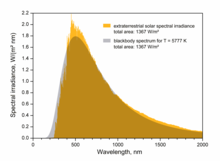
The effective temperature, or black body
temperature, of the Sun (5777 K) is the temperature a black body of the
same size must have to yield the same total emissive power.
Main article: Photosphere
The visible surface of the Sun, the photosphere, is the layer below which the Sun becomes opaque to visible light.[64]
Above the photosphere visible sunlight is free to propagate into space,
and its energy escapes the Sun entirely. The change in opacity is due
to the decreasing amount of H− ions, which absorb visible light easily.[64] Conversely, the visible light we see is produced as electrons react with hydrogen atoms to produce H− ions.[65][66] The photosphere is tens to hundreds of kilometers thick, being slightly less opaque than air
on Earth. Because the upper part of the photosphere is cooler than the
lower part, an image of the Sun appears brighter in the center than on
the edge or limb of the solar disk, in a phenomenon known as limb darkening.[64] The spectrum of sunlight has approximately the spectrum of a black-body radiating at about 6,000 K, interspersed with atomic absorption lines from the tenuous layers above the photosphere. The photosphere has a particle density of ~1023 m−3 (about 0.37% of the particle number per volume of the Earth's atmosphere
at sea level). The photosphere is not fully ionized—the extent of
ionization is about 3%, leaving almost all of the hydrogen in atomic
form.[67]During early studies of the optical spectrum of the photosphere, some absorption lines were found that did not correspond to any chemical elements then known on Earth. In 1868, Norman Lockyer hypothesized that these absorption lines were caused by a new element which he dubbed helium, after the Greek Sun god Helios. Twenty-five years later, helium was isolated on Earth.[68]
Atmosphere
See also: Corona and Coronal loop

During a total solar eclipse, the solar corona can be seen with the naked eye, during the brief period of totality.
The coolest layer of the Sun is a temperature minimum region about 500 km above the photosphere, with a temperature of about 4100 K.[64] This part of the Sun is cool enough to allow the existence of simple molecules such as carbon monoxide and water, which can be detected via their absorption spectra.[69]
The chromosphere, transition region, and corona are much hotter than the surface of the Sun.[64] The reason has not been conclusively proven; evidence suggests that Alfvén waves may have enough energy to heat the corona.[70]
Above the temperature minimum layer is a layer about 2000 km thick, dominated by a spectrum of emission and absorption lines.[64] It is called the chromosphere from the Greek root chroma, meaning color, because the chromosphere is visible as a colored flash at the beginning and end of total solar eclipses.[61] The temperature in the chromosphere increases gradually with altitude, ranging up to around 20000 K near the top.[64] In the upper part of the chromosphere helium becomes partially ionized.[71]

Taken by Hinode's
Solar Optical Telescope on 12 January 2007, this image of the Sun
reveals the filamentary nature of the plasma connecting regions of
different magnetic polarity.
The corona is the next layer of the Sun. The low corona, near the surface of the Sun, has a particle density around 1015–1016 m−3.[71][e] The average temperature of the corona and solar wind is about 1,000,000–2,000,000 K; however, in the hottest regions it is 8,000,000–20,000,000 K.[72] While no complete theory yet exists to account for the temperature of the corona, at least some of its heat is known to be from magnetic reconnection.[72][74] The corona is the extended atmosphere of the Sun, which has volume much larger than the volume enclosed by the Sun's photosphere. Waves at the outer surface of the corona which randomly blow to even further distance from the Sun is called the solar wind, and is one of the Sun's influence to the whole Solar System.[74]
The heliosphere, the tenuous outermost atmosphere of the Sun, is filled with the solar wind plasma. This outermost layer of the Sun is defined to begin at the distance where the flow of the solar wind becomes superalfvénic—that is, where the flow becomes faster than the speed of Alfvén waves,[75] at approximately 20 solar radii (0.1 AU). Turbulence and dynamic forces in the heliosphere cannot affect the shape of the solar corona within, because the information can only travel at the speed of Alfvén waves. The solar wind travels outward continuously through the heliosphere, forming the solar magnetic field into a spiral shape,[74] until it impacts the heliopause more than 50 AU from the Sun. In December 2004, the Voyager 1 probe passed through a shock front that is thought to be part of the heliopause. Both of the Voyager probes have recorded higher levels of energetic particles as they approach the boundary.[76]
The heliosphere extends to the outer fringe of the Solar System, farther than the orbit of Pluto, is defined to end at the heliopause, which is the end of influence from the Sun, and is the boundary with the interstellar medium.
Magnetic field
See also: Stellar magnetic field

In this false-color ultraviolet image, the Sun shows a C3-class solar
flare (white area on upper left), a solar tsunami (wave-like structure,
upper right) and multiple filaments of plasma following a magnetic field, rising from the stellar surface.
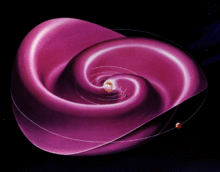
The heliospheric current sheet extends to the outer reaches of the Solar System, and results from the influence of the Sun's rotating magnetic field on the plasma in the interplanetary medium.[77]
All matter in the Sun is in the form of gas and, at high temperatures, plasma. This makes it possible for the Sun to rotate faster at its equator (about 25 days) than it does at more extreme latitudes (about 35 days near its poles). The differential rotation of the Sun's latitudes causes its magnetic field lines to become twisted together over time, producing magnetic field loops to erupt from the Sun's surface and trigger the formation of the Sun's dramatic sunspots and solar prominences (see magnetic reconnection). This twisting action creates the solar dynamo and an 11-year solar cycle of magnetic activity as the Sun's magnetic field reverses itself about every 11 years.[81][82]
The solar magnetic field extends well beyond the Sun itself. The magnetized solar wind plasma carries the Sun's magnetic field into space forming what is called the interplanetary magnetic field.[74] Since the plasma can only move along the magnetic field lines, the interplanetary magnetic field is initially stretched radially away from the Sun. Because the fields north and south of the solar equator have different polarities pointing toward and away from the Sun, there exists a thin current layer in the solar equatorial plane, which is called the heliospheric current sheet.[74] At great distances, the rotation of the Sun twists the magnetic field and the current sheet into the Archimedean spiral like structure called the Parker spiral.[74] The interplanetary magnetic field is much stronger than the dipole component of the solar magnetic field. The Sun's dipole magnetic field of 50–400 μT (at the photosphere) reduces with the inverse-cube of the distance to about 0.1 nT at the distance of the Earth. However, according to spacecraft observations the interplanetary field at the Earth's location is around 5 nT, about a hundred times greater.[83] The difference is due to magnetic fields generated by electrical currents in the plasma surrounding the Sun.
Chemical composition

Image taken by NASA STEREO probes launched in 2006; utilizing two spacecraft to image the Sun at the extreme UV wavelength (171 Å).
“From a chemist’s point of view, the surface or interior of a star…is boring—there are no molecules there.”—Roald Hoffmann[84]
See also: Molecules in stars
The Sun is composed primarily of the chemical elements hydrogen and helium; they account for 74.9% and 23.8% of the mass of the Sun in the photosphere, respectively.[85] All heavier elements, called metals
in astronomy, account for less than 2% of the mass. The most abundant
metals are oxygen (roughly 1% of the Sun's mass), carbon (0.3%), neon
(0.2%), and iron (0.2%).[86]The Sun inherited its chemical composition from the interstellar medium out of which it formed. The hydrogen and helium in the Sun were produced by Big Bang nucleosynthesis, and the metals were produced by stellar nucleosynthesis in generations of stars that completed their stellar evolution and returned their material to the interstellar medium before the formation of the Sun.[87] The chemical composition of the photosphere is normally considered representative of the composition of the primordial Solar System.[88] However, since the Sun formed, some of the helium and heavy elements have gravitationally settled from the photosphere. Therefore, in today's photosphere the helium fraction is reduced and the metallicity is only 84% of that in the protostellar phase (before nuclear fusion in the core started). The protostellar Sun's composition was reconstructed as 71.1% hydrogen, 27.4% helium, and 1.5% metals.[85]
In the inner portions of the Sun, nuclear fusion has modified the composition by converting hydrogen into helium, so the innermost portion of the Sun is now roughly 60% helium, with the metal abundance unchanged. Because the interior of the Sun is radiative, not convective (see Radiative zone above), none of the fusion products from the core have risen to the photosphere.[89]
The reactive core zone of "hydrogen burning", where hydrogen is converted into helium, is starting to surround the core of "helium ash". This development will continue and will eventually cause the Sun to leave the main sequence, to become a red giant[90]
The solar heavy-element abundances described above are typically measured both using spectroscopy of the Sun's photosphere and by measuring abundances in meteorites that have never been heated to melting temperatures. These meteorites are thought to retain the composition of the protostellar Sun and are thus not affected by settling of heavy elements. The two methods generally agree well.[15]
Singly ionized iron group elements
In the 1970s, much research focused on the abundances of iron group elements in the Sun.[91][92] Although significant research was done, the abundance determination of some iron group elements (e.g. cobalt and manganese) was still difficult at least as far as 1978 because of their hyperfine structures.[91]The first largely complete set of oscillator strengths of singly ionized iron group elements were made available first in the 1960s,[93] and improved oscillator strengths were computed in 1976.[94] In 1978 the abundances of 'singly Ionized' elements of the iron group were derived.[91]
Solar and planetary mass fractionation relationship
Various authors have considered the existence of a mass fractionation relationship between the isotopic compositions of solar and planetary noble gases,[95] for example correlations between isotopic compositions of planetary and solar neon and xenon.[96] Nevertheless, the belief that the whole Sun has the same composition as the solar atmosphere was still widespread, at least until 1983.[97]In 1983, it was claimed that it was the fractionation in the Sun itself that caused the fractionation relationship between the isotopic compositions of planetary and solar wind implanted noble gases.[97]
Solar cycles
Main articles: Sunspots and List of solar cycles
Sunspots and the sunspot cycle
When observing the Sun with appropriate filtration, the most immediately visible features are usually its sunspots, which are well-defined surface areas that appear darker than their surroundings because of lower temperatures. Sunspots are regions of intense magnetic activity where convection is inhibited by strong magnetic fields, reducing energy transport from the hot interior to the surface. The magnetic field causes strong heating in the corona, forming active regions that are the source of intense solar flares and coronal mass ejections. The largest sunspots can be tens of thousands of kilometers across.[98]The number of sunspots visible on the Sun is not constant, but varies over an 11-year cycle known as the solar cycle. At a typical solar minimum, few sunspots are visible, and occasionally none at all can be seen. Those that do appear are at high solar latitudes. As the sunspot cycle progresses, the number of sunspots increases and they move closer to the equator of the Sun, a phenomenon described by Spörer's law. Sunspots usually exist as pairs with opposite magnetic polarity. The magnetic polarity of the leading sunspot alternates every solar cycle, so that it will be a north magnetic pole in one solar cycle and a south magnetic pole in the next.[99]
Possible long-term cycle
A recent theory claims that there are magnetic instabilities in the core of the Sun that cause fluctuations with periods of either 41,000 or 100,000 years. These could provide a better explanation of the ice ages than the Milankovitch cycles.[103][104]Life phases
Main articles: Formation and evolution of the Solar System and Stellar evolution
The Sun today is roughly halfway through the most stable part of its life. It has not changed dramatically for four billion[a]
years, and will remain fairly stable for four billion more. However
after hydrogen fusion in its core has stopped, the Sun will undergo
severe changes, both internally and externally.Formation
The Sun was formed about 4.57 billion years ago from the collapse of part of a giant molecular cloud that consisted mostly of hydrogen and helium and which probably gave birth to many other stars.[105] This age is estimated using computer models of stellar evolution and through nucleocosmochronology.[8] The result is consistent with the radiometric date of the oldest Solar System material, at 4.567 billion years ago.[106][107] Studies of ancient meteorites reveal traces of stable daughter nuclei of short-lived isotopes, such as iron-60, that form only in exploding, short-lived stars. This indicates that one or more supernovae must have occurred near the location where the Sun formed. A shock wave from a nearby supernova would have triggered the formation of the Sun by compressing the gases within the molecular cloud and causing certain regions to collapse under their own gravity.[108] As one fragment of the cloud collapsed it also began to rotate due to conservation of angular momentum and heat up with the increasing pressure. Much of the mass became concentrated in the center, while the rest flattened out into a disk which would become the planets and other solar system bodies. Gravity and pressure within the core of the cloud generated a lot of heat as it accreted more gas from the surrounding disk, eventually triggering nuclear fusion. Thus, the Sun was born.Main sequence
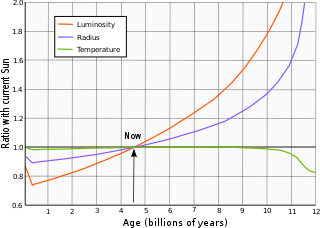
Evolution of the Sun's luminosity, radius and effective temperature compared to the present Sun. After Ribas (2010)[109]
After core hydrogen exhaustion

The size of the current Sun (now in the main sequence) compared to its estimated size during its red giant phase in the future
Even before it becomes a red giant, the luminosity of the Sun will have nearly doubled, and the Earth will be hotter than Venus is today. Once the core hydrogen is exhausted in 5.4 billion years, the Sun will expand into a subgiant phase and slowly double in size over about half a billion years. It will then expand more rapidly over about half a billion years until it is over two hundred times larger than today and a couple of thousand times more luminous. This then starts the red giant branch (RGB) phase where the Sun will spend around a billion years and lose around a third of its mass.[112]

Evolution of a sun-like star. The track of a one solar mass star on the Hertzsprung–Russell diagram is shown from the main sequence to the post-AGB stage.
When the helium is exhausted, the Sun will repeat the expansion it followed when the hydrogen in the core was exhausted, except that this time it all happens faster, and the Sun becomes larger and more luminous. This is the asymptotic giant branch (AGB) phase, and the Sun is alternately burning hydrogen in a shell or helium in a deeper shell. After about 20 million years on the early AGB, the Sun becomes increasingly unstable, with rapid mass loss and thermal pulses that increase the size and luminosity for a few hundred years every 100,000 years or so. The thermal pulses become larger each time, with the later pulses pushing the luminosity to as much as 5,000 times the current level and the radius to over 1 AU.[113] Models vary depending on the rate and timing of mass loss. Models that have higher mass loss on the RGB produce smaller, less luminous stars at the tip of the AGB, perhaps only 2,000 times the luminosity and less than 200 times the radius.[112] For the Sun, four thermal pulses are predicted before it completely loses its outer envelope and starts to make a planetary nebula. By the end of that phase – lasting approximately 500,000 years – the Sun will only have about half of its current mass.
The post AGB evolution is even faster. The luminosity stays approximately constant while the temperature increases, with the ejected half of the Sun's mass becoming ionised into a planetary nebula as the exposed core reaches 30,000K. The final naked core temperature will be over 100,000K, after which the remnant will cool towards a white dwarf. The planetary nebula will disperse in about 10,000 years, but the white dwarf will survive for trillions of years before fading to black.[114][115]
Earth's fate
Main article: Future of the Earth
Sunlight
Main article: Sunlight
Sunlight on the surface of Earth is attenuated by the Earth's atmosphere so that less power arrives at the surface—closer to 1000 W/m2 in clear conditions when the Sun is near the zenith.[120] The atmosphere in particular filters out over 70% of solar ultraviolet, especially at the shorter wavelengths.[121]
Solar energy can be harnessed by a variety of natural and synthetic processes—photosynthesis by plants captures the energy of sunlight and converts it to chemical form (oxygen and reduced carbon compounds), while direct heating or electrical conversion by solar cells are used by solar power equipment to generate electricity or to do other useful work, sometimes employing concentrating solar power (that it is measured in suns). The energy stored in petroleum and other fossil fuels was originally converted from sunlight by photosynthesis in the distant past.[122]
Motion and location
See also: Barycentric coordinates (astronomy)
The Sun lies close to the inner rim of the Milky Way Galaxy's Orion Arm, in the Local Fluff or the Gould Belt, at a hypothesized distance of 7.5–8.5 kpc (25,000–28,000 light-years) from the Galactic Center,[123][124][125][126] contained within the Local Bubble, a space of rarefied hot gas, possibly produced by the supernova remnant, Geminga.[127] The distance between the local arm and the next arm out, the Perseus Arm, is about 6,500 light-years.[128] The Sun, and thus the Solar System, is found in what scientists call the galactic habitable zone.The Apex of the Sun's Way, or the solar apex, is the direction that the Sun travels through space in the Milky Way, relative to other nearby stars. The general direction of the Sun's galactic motion is towards the star Vega in the constellation of Lyra at an angle of roughly 60 sky degrees to the direction of the Galactic Center.
The Sun's orbit around the Galaxy is expected to be roughly elliptical with the addition of perturbations due to the galactic spiral arms and non-uniform mass distributions. In addition the Sun oscillates up and down relative to the galactic plane approximately 2.7 times per orbit. It has been argued that the Sun's passage through the higher density spiral arms often coincides with mass extinctions on Earth, perhaps due to increased impact events.[129] It takes the Solar System about 225–250 million years to complete one orbit of the galaxy (a galactic year),[130] so it is thought to have completed 20–25 orbits during the lifetime of the Sun. The orbital speed of the Solar System about the center of the Galaxy is approximately 251 km/s (156 mi/s).[131] At this speed, it takes around 1,190 years for the Solar System to travel a distance of 1 light-year, or 7 days to travel 1 AU.[132]

Motion of the barycenter of the Solar System relative to the Sun
Theoretical problems
Coronal heating problem
Main article: Corona
The optical surface of the Sun (the photosphere) is known to have a temperature of approximately 6,000 K. Above it lies the solar corona, rising to a temperature of 1,000,000–2,000,000 K.[72] The high temperature of the corona shows that it is heated by something other than direct heat conduction from the photosphere.[74]It is thought that the energy necessary to heat the corona is provided by turbulent motion in the convection zone below the photosphere, and two main mechanisms have been proposed to explain coronal heating.[72] The first is wave heating, in which sound, gravitational or magnetohydrodynamic waves are produced by turbulence in the convection zone.[72] These waves travel upward and dissipate in the corona, depositing their energy in the ambient gas in the form of heat.[134] The other is magnetic heating, in which magnetic energy is continuously built up by photospheric motion and released through magnetic reconnection in the form of large solar flares and myriad similar but smaller events—nanoflares.[135]
Currently, it is unclear whether waves are an efficient heating mechanism. All waves except Alfvén waves have been found to dissipate or refract before reaching the corona.[136] In addition, Alfvén waves do not easily dissipate in the corona. Current research focus has therefore shifted towards flare heating mechanisms.[72]
Faint young Sun problem
Main article: Faint young Sun paradox
Theoretical models of the Sun's development suggest that 3.8 to 2.5 billion years ago, during the Archean period,
the Sun was only about 75% as bright as it is today. Such a weak star
would not have been able to sustain liquid water on the Earth's surface,
and thus life should not have been able to develop. However, the
geological record demonstrates that the Earth has remained at a fairly
constant temperature throughout its history, and that the young Earth
was somewhat warmer than it is today. The consensus among scientists is
that the young Earth's atmosphere contained much larger quantities of greenhouse gases (such as carbon dioxide, methane and/or ammonia) than are present today, which trapped enough heat to compensate for the smaller amount of solar energy reaching the planet.[137]History of observation
Early understanding
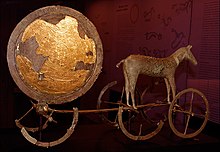
The Trundholm Sun chariot pulled by a horse is a sculpture believed to be illustrating an important part of Nordic Bronze Age mythology. The sculpture is probably from around 1350 BC. It is displayed at the National Museum of Denmark.
See also: The Sun in culture
Like other natural phenomena, the Sun has been an object of
veneration in many cultures throughout human history. Humanity's most
fundamental understanding of the Sun is as the luminous disk in the sky, whose presence above the horizon creates day and whose absence causes night. In many prehistoric and ancient cultures, the Sun was thought to be a solar deity or other supernatural phenomenon. Worship of the Sun was central to civilizations such as the ancient Egyptians, the Inca of South America and the Aztecs of what is now Mexico. In religions such as Hinduism, the Sun is still considered a God. Many ancient monuments were constructed with solar phenomena in mind; for example, stone megaliths accurately mark the summer or winter solstice (some of the most prominent megaliths are located in Nabta Playa, Egypt; Mnajdra, Malta and at Stonehenge, England); Newgrange, a prehistoric human-built mount in Ireland, was designed to detect the winter solstice; the pyramid of El Castillo at Chichén Itzá in Mexico is designed to cast shadows in the shape of serpents climbing the pyramid at the vernal and autumn equinoxes.The Egyptians portrayed Ra (=the sun) as being carried across the sky in a solar barque, accompanied by lesser gods, and to the Greeks, he was Helios, carried by a chariot drawn by fiery horses. From the reign of Elagabalus in the late Roman Empire the Sun's birthday was a holiday celebrated as Sol Invictus (literally “unconquered sun”) soon after the winter solstice which may have been an antecedent to Christmas. Regarding the fixed stars, the Sun appears from Earth to revolve once a year along the ecliptic through the zodiac, and so Greek astronomers considered it to be one of the seven planets (Greek planetes, “wanderer”), after which the seven days of the week are named in some languages.[138][139][140]
Development of scientific understanding
One of the first people to offer a scientific or philosophical explanation for the Sun was the Greek philosopher Anaxagoras, who reasoned that it was a giant flaming ball of metal even larger than the Peloponnesus rather than the chariot of Helios, and that the Moon reflected the light of the Sun.[142] For teaching this heresy, he was imprisoned by the authorities and sentenced to death, though he was later released through the intervention of Pericles. Eratosthenes estimated the distance between the Earth and the Sun in the 3rd century BC as "of stadia myriads 400 and 80000", the translation of which is ambiguous, implying either 4,080,000 stadia (755,000 km) or 804,000,000 stadia (148 to 153 million kilometers or 0.99 to 1.02 AU); the latter value is correct to within a few percent. In the 1st century AD, Ptolemy estimated the distance as 1,210 times the Earth radius, approximately 7.71 million kilometers (0.0515 AU).[143]
The theory that the Sun is the center around which the planets move was first proposed by the ancient Greek Aristarchus of Samos in the 3rd century BC, and later adopted by Seleucus of Seleucia (see Heliocentrism). This largely philosophical view was developed into fully predictive mathematical model of a heliocentric system in the 16th century by Nicolaus Copernicus. In the early 17th century, the invention of the telescope permitted detailed observations of sunspots by Thomas Harriot, Galileo Galilei and other astronomers. Galileo made some of the first known telescopic observations of sunspots and posited that they were on the surface of the Sun rather than small objects passing between the Earth and the Sun.[144] Sunspots were also observed since the Han Dynasty (206 BC – AD 220) by Chinese astronomers who maintained records of these observations for centuries. Averroes also provided a description of sunspots in the 12th century.[145]
Arabic astronomical contributions include Albatenius' discovery that the direction of the Sun's apogee (the place in the Sun's orbit against the fixed stars where it seems to be moving slowest) is changing.[146] (In modern heliocentric terms, this is caused by a gradual motion of the aphelion of the Earth's orbit). Ibn Yunus observed more than 10,000 entries for the Sun's position for many years using a large astrolabe.[147]

Sol, the Sun, from a 1550 edition of Guido Bonatti's Liber astronomiae.
Isaac Newton observed the Sun's light using a prism, and showed that it was made up of light of many colors,[149] while in 1800 William Herschel discovered infrared radiation beyond the red part of the solar spectrum.[150] The 19th century saw advancement in spectroscopic studies of the Sun; Joseph von Fraunhofer recorded more than 600 absorption lines in the spectrum, the strongest of which are still often referred to as Fraunhofer lines. In the early years of the modern scientific era, the source of the Sun's energy was a significant puzzle. Lord Kelvin suggested that the Sun was a gradually cooling liquid body that was radiating an internal store of heat.[151] Kelvin and Hermann von Helmholtz then proposed a gravitational contraction mechanism to explain the energy output, but the resulting age estimate was only 20 million years, well short of the time span of at least 300 million years suggested by some geological discoveries of that time.[151] In 1890 Joseph Lockyer, who discovered helium in the solar spectrum, proposed a meteoritic hypothesis for the formation and evolution of the Sun.[152]
Not until 1904 was a documented solution offered. Ernest Rutherford suggested that the Sun's output could be maintained by an internal source of heat, and suggested radioactive decay as the source.[153] However, it would be Albert Einstein who would provide the essential clue to the source of the Sun's energy output with his mass-energy equivalence relation E = mc2.[154] In 1920, Sir Arthur Eddington proposed that the pressures and temperatures at the core of the Sun could produce a nuclear fusion reaction that merged hydrogen (protons) into helium nuclei, resulting in a production of energy from the net change in mass.[155] The preponderance of hydrogen in the Sun was confirmed in 1925 by Cecilia Payne using the ionization theory developed by Meghnad Saha, an Indian physicist. The theoretical concept of fusion was developed in the 1930s by the astrophysicists Subrahmanyan Chandrasekhar and Hans Bethe. Hans Bethe calculated the details of the two main energy-producing nuclear reactions that power the Sun.[156][157] Finally, a seminal paper entitled "Synthesis of the Elements in Stars" was published in 1957 by Margaret Burbidge, Geoffrey Burbidge, William Fowler and Fred Hoyle.[158] The paper demonstrated convincingly that most of the elements in the universe had been synthesized by nuclear reactions inside stars, some like the Sun.
Solar space missions
See also: Solar observatory
In the 1970s, two Helios spacecraft and the Skylab Apollo Telescope Mount provided scientists with significant new data on solar wind and the solar corona. The Helios 1 and 2 probes were U.S.–German collaborations that studied the solar wind from an orbit carrying the spacecraft inside Mercury's orbit at perihelion.[162] The Skylab space station, launched by NASA in 1973, included a solar observatory module called the Apollo Telescope Mount that was operated by astronauts resident on the station.[73] Skylab made the first time-resolved observations of the solar transition region and of ultraviolet emissions from the solar corona.[73] Discoveries included the first observations of coronal mass ejections, then called "coronal transients", and of coronal holes, now known to be intimately associated with the solar wind.[162]
In 1980, the Solar Maximum Mission was launched by NASA. This spacecraft was designed to observe gamma rays, X-rays and UV radiation from solar flares during a time of high solar activity and solar luminosity. Just a few months after launch, however, an electronics failure caused the probe to go into standby mode, and it spent the next three years in this inactive state. In 1984 Space Shuttle Challenger mission STS-41C retrieved the satellite and repaired its electronics before re-releasing it into orbit. The Solar Maximum Mission subsequently acquired thousands of images of the solar corona before re-entering the Earth's atmosphere in June 1989.[163]
Launched in 1991, Japan's Yohkoh (Sunbeam) satellite observed solar flares at X-ray wavelengths. Mission data allowed scientists to identify several different types of flares, and demonstrated that the corona away from regions of peak activity was much more dynamic and active than had previously been supposed. Yohkoh observed an entire solar cycle but went into standby mode when an annular eclipse in 2001 caused it to lose its lock on the Sun. It was destroyed by atmospheric re-entry in 2005.[164]
One of the most important solar missions to date has been the Solar and Heliospheric Observatory, jointly built by the European Space Agency and NASA and launched on 2 December 1995.[73] Originally intended to serve a two-year mission, a mission extension through 2012 was approved in October 2009.[165] It has proven so useful that a follow-on mission, the Solar Dynamics Observatory (SDO), was launched in February 2010.[166] Situated at the Lagrangian point between the Earth and the Sun (at which the gravitational pull from both is equal), SOHO has provided a constant view of the Sun at many wavelengths since its launch.[73] Besides its direct solar observation, SOHO has enabled the discovery of a large number of comets, mostly tiny sungrazing comets which incinerate as they pass the Sun.[167]
All these satellites have observed the Sun from the plane of the ecliptic, and so have only observed its equatorial regions in detail. The Ulysses probe was launched in 1990 to study the Sun's polar regions. It first travelled to Jupiter, to "slingshot" past the planet into an orbit which would take it far above the plane of the ecliptic. Serendipitously, it was well-placed to observe the collision of Comet Shoemaker-Levy 9 with Jupiter in 1994. Once Ulysses was in its scheduled orbit, it began observing the solar wind and magnetic field strength at high solar latitudes, finding that the solar wind from high latitudes was moving at about 750 km/s which was slower than expected, and that there were large magnetic waves emerging from high latitudes which scattered galactic cosmic rays.[168]
Elemental abundances in the photosphere are well known from spectroscopic studies, but the composition of the interior of the Sun is more poorly understood. A solar wind sample return mission, Genesis, was designed to allow astronomers to directly measure the composition of solar material. Genesis returned to Earth in 2004 but was damaged by a crash landing after its parachute failed to deploy on re-entry into Earth's atmosphere. Despite severe damage, some usable samples have been recovered from the spacecraft's sample return module and are undergoing analysis.[169]
The Solar Terrestrial Relations Observatory (STEREO) mission was launched in October 2006. Two identical spacecraft were launched into orbits that cause them to (respectively) pull further ahead of and fall gradually behind the Earth. This enables stereoscopic imaging of the Sun and solar phenomena, such as coronal mass ejections.[170][171]
The Indian Space Research Organisation has scheduled the launch of a 100 kg satellite named Aditya for 2015–16. Its main instrument will be a coronagraph for studying the dynamics of the Solar corona.[172]
Observation and effects

The Sun, as seen from low Earth orbit overlooking the International Space Station. This sunlight is not filtered by the lower atmosphere, which blocks many wavelengths of light
Viewing the Sun through light-concentrating optics such as binoculars may result in permanent damage to the retina without an appropriate filter that blocks UV and substantially dims the sunlight. When using an attenuating filter to view the Sun, the viewer is cautioned to use a filter specifically designed for that use. Some improvised filters that pass UV or IR rays, can actually harm the eye at high brightness levels.[180] Herschel wedges, also called Solar Diagonals, are effective and inexpensive for small telescopes. The sunlight that is destined for the eyepiece is reflected from an unsilvered surface of a piece of glass. Only a very small fraction of the incident light is reflected. The rest passes through the glass and leaves the instrument. If the glass breaks because of the heat, no light at all is reflected, making the device fail-safe. Simple filters made of darkened glass allow the full intensity of sunlight to pass through if they break, endangering the observer's eyesight. Unfiltered binoculars can deliver hundreds of times as much energy as using the naked eye, possibly causing immediate damage. It is claimed that even brief glances at the midday Sun through an unfiltered telescope can cause permanent damage.[181]
Partial solar eclipses are hazardous to view because the eye's pupil is not adapted to the unusually high visual contrast: the pupil dilates according to the total amount of light in the field of view, not by the brightest object in the field. During partial eclipses most sunlight is blocked by the Moon passing in front of the Sun, but the uncovered parts of the photosphere have the same surface brightness as during a normal day. In the overall gloom, the pupil expands from ~2 mm to ~6 mm, and each retinal cell exposed to the solar image receives up to ten times more light than it would looking at the non-eclipsed Sun. This can damage or kill those cells, resulting in small permanent blind spots for the viewer.[182] The hazard is insidious for inexperienced observers and for children, because there is no perception of pain: it is not immediately obvious that one's vision is being destroyed.

The Sun as it appears from the surface of the Earth at sunrise.

The Sun as it appears from the surface of the Earth at sunset.
A rare optical phenomenon may occur shortly after sunset or before sunrise, known as a green flash. The flash is caused by light from the Sun just below the horizon being bent (usually through a temperature inversion) towards the observer. Light of shorter wavelengths (violet, blue, green) is bent more than that of longer wavelengths (yellow, orange, red) but the violet and blue light is scattered more, leaving light that is perceived as green.[185]
Ultraviolet light from the Sun has antiseptic properties and can be used to sanitize tools and water. It also causes sunburn, and has other medical effects such as the production of vitamin D. Ultraviolet light is strongly attenuated by Earth's ozone layer, so that the amount of UV varies greatly with latitude and has been partially responsible for many biological adaptations, including variations in human skin color in different regions of the globe.[186]
This article is about the star. For other uses, see Sun (disambiguation).

|
|
| Observation data | |
|---|---|
| Mean distance from Earth |
1.496×108 km 8 min 19 s at light speed |
| Visual brightness (V) | −26.74[1] |
| Absolute magnitude | 4.83[1] |
| Spectral classification | G2V |
| Metallicity | Z = 0.0122[2] |
| Angular size | 31.6–32.7′[3] |
| Adjectives | Solar |
| Orbital characteristics | |
| Mean distance from Milky Way core |
≈ 2.7×1017 km 27200 light-years |
| Galactic period | (2.25–2.50)×108 a (years) |
| Velocity | ≈ 220 km/s (orbit around the center of the Galaxy) ≈ 20 km/s (relative to average velocity of other stars in stellar neighborhood) ≈ 370 km/s[4] (relative to the cosmic microwave background) |
| Physical characteristics | |
| Equatorial radius | 696342±65 km[5] 109 × Earth[6] |
| Equatorial circumference | 4.379×106 km[6] 109 × Earth[6] |
| Flattening | 9×10−6 |
| Surface area | 6.09×1012 km2[6] 12000 × Earth[6] |
| Volume | 1.41×1018 km3[6] 1300000 × Earth |
| Mass | (1.98855±0.00025)×1030 kg[1] 333000 × Earth[1] |
| Average density | 1.408×103 kg/m3[1][6][7] 0.255 × Earth[1][6] |
| Density | Center (model): 1.622×105 kg/m3[1] |
| Equatorial surface gravity | 274.0 m/s2[1]
27.94 g
27542.29 cgs 28 × Earth[6] |
| Escape velocity (from the surface) |
617.7 km/s[6] 55 × Earth[6] |
| Temperature | Center (modeled): ≈ 1.57×107 K[1] Photosphere (effective): 5778 K[1] Corona: ≈ 5×106 K |
| Luminosity (Lsol) | 3.846×1026 W[1] ≈ 3.75×1028 lm ≈ 98 lm/W efficacy |
| Mean radiance (Isol) | 2.009×107 W·m−2·sr−1 |
| Age | ≈4.6 billion years[8][9] |
| Rotation characteristics | |
| Obliquity | 7.25°[1]
(to the ecliptic) 67.23° (to the galactic plane) |
| Right ascension of North pole[10] |
286.13° 19 h 4 min 30 s |
| Declination of North pole |
+63.87° 63° 52' North |
| Sidereal rotation period (at equator) |
25.05 days[1] |
| (at 16° latitude) | 25.38 days[1] 25 d 9 h 7 min 12 s[10] |
| (at poles) | 34.4 days[1] |
| Rotation velocity (at equator) |
7.189×103 km/h[6] |
| Photospheric composition (by mass) | |
| Hydrogen | 73.46%[11] |
| Helium | 24.85% |
| Oxygen | 0.77% |
| Carbon | 0.29% |
| Iron | 0.16% |
| Neon | 0.12% |
| Nitrogen | 0.09% |
| Silicon | 0.07% |
| Magnesium | 0.05% |
| Sulfur | 0.04% |
The Sun formed about 4.567 billion[a][16] years ago from the gravitational collapse of a region within a large molecular cloud. Most of the matter gathered in the center, while the rest flattened into an orbiting disk that would become the Solar System. The central mass became increasingly hot and dense, eventually initiating thermonuclear fusion in its core. It is thought that almost all stars form by this process. The Sun is a G-type main-sequence star (G2V) based on spectral class and it is informally designated as a yellow dwarf because its visible radiation is most intense in the yellow-green portion of the spectrum, and although it is actually white in color, from the surface of the Earth it may appear yellow because of atmospheric scattering of blue light.[17] In the spectral class label, G2 indicates its surface temperature, of approximately 5778 K (5505 °C), and V indicates that the Sun, like most stars, is a main-sequence star, and thus generates its energy by nuclear fusion of hydrogen nuclei into helium. In its core, the Sun fuses about 620 million metric tons of hydrogen each second.[18][19]
Once regarded by astronomers as a small and relatively insignificant star, the Sun is now thought to be brighter than about 85% of the stars in the Milky Way, most of which are red dwarfs.[20][21] The absolute magnitude of the Sun is +4.83; however, as the star closest to Earth, the Sun is by far the brightest object in the sky with an apparent magnitude of −26.74.[22][23] This is about 13 billion times brighter than the next brightest star, Sirius, with an apparent magnitude of −1.46. The Sun's hot corona continuously expands in space creating the solar wind, a stream of charged particles that extends to the heliopause at roughly 100 astronomical units. The bubble in the interstellar medium formed by the solar wind, the heliosphere, is the largest continuous structure in the Solar System.[24][25]
The Sun is currently traveling through the Local Interstellar Cloud (near to the G-cloud) in the Local Bubble zone, within the inner rim of the Orion Arm of the Milky Way.[26][27] Of the 50 nearest stellar systems within 17 light-years from Earth (the closest being a red dwarf named Proxima Centauri at approximately 4.2 light-years away), the Sun ranks fourth in mass.[28] The Sun orbits the center of the Milky Way at a distance of approximately 24000–26000 light-years from the galactic center, completing one clockwise orbit, as viewed from the galactic north pole, in about 225–250 million years. Since the Milky Way is moving with respect to the cosmic microwave background radiation (CMB) in the direction of the constellation Hydra with a speed of 550 km/s, the Sun's resultant velocity with respect to the CMB is about 370 km/s in the direction of Crater or Leo.[29]
The mean distance of the Sun from the Earth is approximately 1 astronomical unit (about 150,000,000 km; 93,000,000 mi), though the distance varies as the Earth moves from perihelion in January to aphelion in July.[30] At this average distance, light travels from the Sun to Earth in about 8 minutes and 19 seconds. The energy of this sunlight supports almost all life[b] on Earth by photosynthesis,[31] and drives Earth's climate and weather. The enormous effect of the Sun on the Earth has been recognized since prehistoric times, and the Sun has been regarded by some cultures as a deity. An accurate scientific understanding of the Sun developed slowly, and as recently as the 19th century prominent scientists had little knowledge of the Sun's physical composition and source of energy. This understanding is still developing; there are a number of present-day anomalies in the Sun's behavior that remain unexplained.




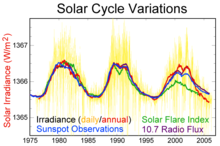



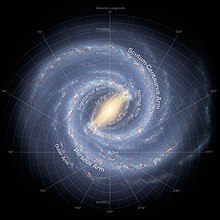




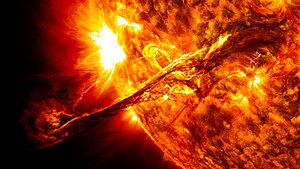

No comments:
Post a Comment